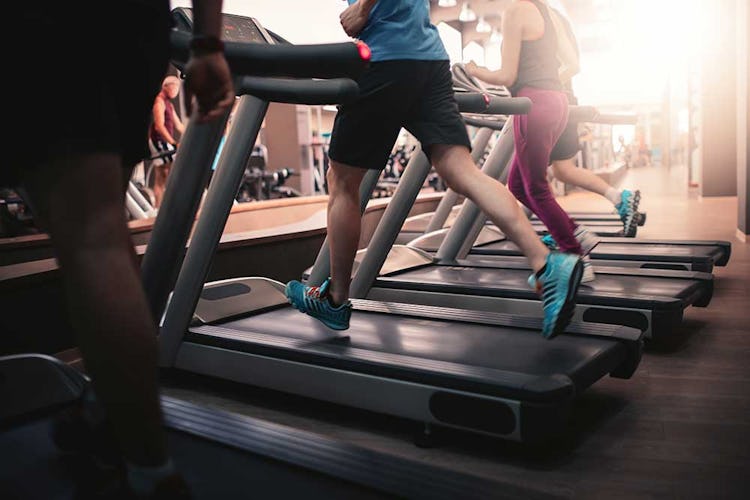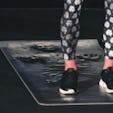A College Student’s Guide To Avoiding The Freshman 15
It happens every year. A lean guy or slim girl graduates high school, goes off to college, and comes home on Thanksgiving break looking like Eric Cartman on Weight Gain 4000: “I’m such a beefcake, I can’t even fit through the door.”
South Park jokes aside, bloating up your first year away at school is a legit concern. A study published in Preventive Medicine reveal that 70–77% of college freshmen do gain weight, and largely during their first semester. Hence the fable of the “Freshman 15”—the idea that you’re apt to gain 15 pounds your first year at college.
Fortunately, research shows you probably won’t gain quite that much, but the study did find that the average gain was nearly eight pounds for both men and women. That’s almost one pound per month for the entire school year, and more than enough to have your friends squinting to recognize you when you come home next summer.
If you’re a new freshman who wants to avoid becoming a statistic, this guide to eating, exercising, and surviving dorm life will help you stay lean through your first year of college.
How Should I Eat To Avoid The Freshman 15?
For the past 18 years, you’ve likely been living with your parents. Unless you’re a budding Gordon Ramsay or Ina Garten, the perks probably included your mom or dad’s cooking. You also had some physical activity built into your schedule, whether it was PE class, playing a school sport, or pick-up games with your friends.
That’s all changed now. You’re responsible for getting your own meals, and if you’re not playing college sports (and odds are that you aren’t: only seven percent of high school athletes go on to play anything in college), you’re susceptible to eating badly and getting lazy. This sets you up to eat more calories than you burn, and that means weight gain.
– Create Awareness
“When people are in high school, food intake probably isn’t even on their radar because it doesn’t have to be,” said Brian St. Pierre, R.D., C.S.C.S., Director of Performance Nutrition at Precision Nutrition. “But when they get to college, a decrease in nutritional quality, increase in quantity, and reduction in exercise can start to take its toll quickly. The best way to avoid this is to start being more aware of your meals and snacks, becoming more mindful of your portion sizes, and committing to making positive changes.”
Check this out: A study published in the International Journal of Obesity divided 75 overweight or obese participants into three groups. The first group focused on forming new eating habits, the second on breaking old eating habits, and the third was a control group that wasn’t asked to change anything. Both of the groups that made changes lost a lot more weight than the control group, and they kept losing weight after the study ended, dropping another 10–12 pounds in the 12 months afterward. However, 65% of the participants in each of the groups met the study goal of shedding at least five percent of their initial bodyweight. In other words, even the control group—comprising people who weren’t asked to change a thing—saw improvements.
The lesson is twofold. Small habit changes can yield big results over time, and simply gaining awareness of your habits (such as the control group did by merely participating in a weight-loss study) can yield results by itself. None of the participants had to follow a specific diet to lose weight. They only needed to become more aware of what they were eating, which automatically led to better choices.
Before you try to make drastic changes to your diet, start paying attention to what you’re eating, how much, when you reach for food, and how often you’re hungry. If you notice that you’re gravitating to pizza and cheeseburgers in the dining hall buffet when chicken breast and cauliflower is also being served, the right decisions will begin to become obvious.
– Control Your Portions
There’s no need to geek out counting calories, weighing food, and micromanaging macronutrients to control your weight. And since most of your meals will probably be served to you, as opposed to you preparing them yourself, you really have no way of knowing for sure how they were made and how many calories are in there anyway.
Keep things simple with Precision Nutrition’s “hand” method. It lets you use the size of your hand to estimate portions of foods that are primarily composed of one macronutrient—protein, carbs, or fat. (Vegetables are included as well, but because their calorie and carb-content is usually low, they get their own category.)
Protein: One serving of meat, seafood, dairy products, or eggs is approximately the length, width, and thickness of the palm of your hand.
For men: 2 servings per meal
For women: 1 serving per meal
Vegetables: One serving of broccoli, carrots, spinach, etc.—raw or cooked—is roughly the size of your closed fist.
For men: 2 servings per meal
For women: 1 serving per meal
Carbs: One serving of fruit, starches (like potatoes or rice), whole grains, or bread is what you can fit in your cupped hand.
For men: 2 servings per meal
For women: 1 portion per meal
Fat: One serving of nuts, seeds, healthy oils (such as coconut, olive), butter, etc. is about the length and thickness of your thumb.
For men: 2 portions per meal
For women: 1 portion per meal
Now you have a customized system for gauging your food intake. Bigger people have bigger hands, and therefore get to eat more. Smaller people with smaller hands get smaller portions. Your hands are always with you, unlike a food scale, so you can keep track of everything you eat, every time. What about calorie-counting apps? If you’ll use one, go for it, but there’s no guarantee of their accuracy, and the hand method is more effective for teaching you what healthy portions of food/reasonably-sized meals look like.
Of course, the hand method gets a little complicated if you’re eating processed foods with mixed macros. For instance, your dining hall lasagna has some protein, and lots of carbs and fat. This is why it’s best to stick with whole foods—the ones that are as close to how you’d find them in nature as possible (e.g. chicken breasts or thighs, steak, a bowl of oatmeal, a scoop of almond butter). But when in doubt, serve yourself one portion of whatever you’re about to eat: one square of lasagna, one slice of pizza or cake, one small bowl of chowder, etc. That should keep your intake of processed foods in check.
The hand system is just a starting point anyway. If you find you’re gaining weight with the portions outlined above, simply skip a cupped hand of carbs at one or more meals, and make further adjustments as needed until you’re seeing the results you want.
BONUS TIP: If you start every meal already feeling somewhat full, you’re less likely to overdo it when you sit down to eat. This is why some dieticians recommend drinking a 16-ounce glass of water before breakfast, lunch, and dinner. The body can’t really tell the difference between satiety that comes from liquids or solids (at least initially), so pounding water can tell your brain that your stomach is fuller than it actually is, helping regulate how much you eat.
Water too boring for you? You may get an even greater effect from a protein shake. Protein is the most satiating macronutrient (compared to carbs and fat), and burns the most calories just to digest it, which is why nutritionists often recommend increasing protein intake for weight loss. A 2013 study in the British Journal of Nutrition found that a thick and creamy protein drink heightens your perception of its protein content, which helps promote the sensation of fullness even further.
For a guide to the benefits of whey protein, go HERE.
– Try Fasting
Pop quiz, college kid: what’s the easiest way to not get fat?
The obvious answer, of course, is simply to not eat. Research shows that intermittent fasting, in which you go certain periods of time without food, has numerous health benefits, including weight loss, improved blood pressure, and even alleviated symptoms of conditions like asthma. Fasting is not appropriate for people who are already underweight or have hormonal problems, but for a healthy college student, it may be the most convenient way to stay lean and get good grades.
When you don’t eat for a while, you trick your body into thinking it’s going to starve. Years of evolution have hard-wired your system to ramp up several processes that help the body become more efficient. Insulin levels drop and growth hormone is released, helping you burn more fat. Your cells begin repairing themselves, and your brain becomes laser-focused—a sign that your body is entering fight-or-flight mode so that you can be an alert hunter.
People who fast report being able to think more clearly and concentrate better on work and other tasks. This could be due to avoiding blood sugar crashes (which are responsible for the energy lulls you feel after big, carb-heavy meals), but it may also be connected to increased production of brain-derived neurotrophic factor (BDNF), a protein that boosts the resistance of the brain’s nerve cells to dysfunction and degeneration.
To start experimenting with fasting, simply skip breakfast in the morning. If you stop eating around 9:00 p.m. the night before and make lunch your first meal of the day at 1:00 p.m, you’ve completed a 16-hour fast—one of the most popular fasting methods and one that most people find easy to stick with. You’re welcome to drink water and/or black coffee during your fast to control hunger (and to help ensure you don’t overeat when you do sit down to a meal).
You don’t have to do intermittent fasting every day. The 17-Hour Fast, by Dr. Frank Merritt, explains that once per week is enough to see some benefit, but as you get more comfortable with the process, you could fast daily and for longer periods.
Try to get your roommate or a friend to fast with you. Your adherence will be better if you have support, and the two of you can compare notes to tweak your fasting approaches and get the most out of it. For a beginner’s guide to intermittent fasting, go HERE.
[Editor’s note: All of the above strategies are low-effort ways to help keep your weight under control. If you want to know more about how to diet for maximum health, performance, or ripped abs, check out our guides to caveman nutrition and keto for starters.]
How Should I Work Out to Avoid The Freshman 15?
Many people think that the only reason to lift weights is to get big and strong, but it’s actually the best way to get leaner. Gaining muscle increases your metabolism 24/7, so you’ll burn extra calories just sitting around in your dorm room.
Not into getting “jacked?” That’s fine. Hitting the weights three days a week is more than enough for you to see dramatic results without anyone confusing you for a bodybuilder (and if you’re a lady, it won’t make you look any less feminine).
A paper published in the European Journal of Applied Physiology found that the following three training methods were equally effective for achieving muscle growth on virtually any exercise you choose to do.
- 3–5 sets of 6–15 repetitions
- 3–5 sets of 10–20 reps
- 3–5 sets of 6–12 reps
Follow one or all of the methods each time you train. Three, non-consecutive, full-body workouts per week is ideal. So you could use method 1 on Monday, 2 on Wednesday, and 3 on Friday. Use the heaviest loads that allow you to complete the number of repetitions called for with good form (any number within the given range is OK). While your training should be challenging, it must also be safe, so stop your sets one to two reps short of the maximum amount you can do with the given weight. For instance, if you’re aiming to do a set of 10–12 reps, and the 10th feels so tough that you think your form would break down if you kept going for 11 or 12, stop the set there.
Change your exercises often. You’ll get the most bang for your muscle-building buck if you focus on compound lifts—those that work multiple joints at once and activate the most muscle. Most of your exercises should come from the following list:
- Deadlift variations (including conventional deadlifts, Romanian deadlifts, trap-bar deadlifts, stiff-legged deadlifts, etc.)
- Squat variations (including back squats, front squats, goblet squats, etc.)
- Bench press (barbell or dumbbell, incline or flat)
- Row (barbell, dumbbell, cable, or band)
- Chinup (or pullup, lat pulldown)
- Overhead press (seated or standing, one arm or two arms)
- Kettlebell swing
- Split squat
- Reverse lunge
A great full-body workout can consist of only three exercises: some kind of pushing movement, a pulling movement, and a lower-body exercise. For example, a dumbbell bench press (pushing), a cable row (pulling), and a kettlebell goblet squat (legs).
For a complete guide to muscle building, see this article. Of course, if your college doesn’t have a good gym, you can also see great results with bodyweight training. Onnit offers a six-week body transformation program—Onnit 6—that you can do in your dorm room with no equipment (eating plans and mindset strategies, and more, are also included). For all the details about Onnit 6, go HERE.
– Cardio
Remember when your parents wanted to lose a few pounds, and they started taking hour-long jogs through the neighborhood?
Suckers.
Research has shown that high-intensity interval training (HIIT)—where you work really hard for a short burst and then coast or rest briefly—is much more time-efficient for both cardiovascular health and fat loss. HIIT workouts usually last 20–30 minutes, and sometimes can be much shorter. One study in the European Journal of Applied Physiology had subjects alternate 10–20-second bouts of all-out cycling on a stationary bike with a few minutes rest for 10 minutes. They did only ONE MINUTE of total work, three days per week. After six weeks, their markers of aerobic capacity had significantly improved.
Meanwhile, a review of HIIT studies in the Journal of Obesity concluded that interval training can burn fat during and after exercise (as the result of an elevated metabolic rate), as well as help to suppress appetite. The authors wrote, “Given that the major reason given for not exercising is time, it is likely that the brevity of [HIIT] protocols should be appealing to most individuals interested in fat reduction.”
Use HIIT 1–3 times per week. Try the following HIIT workouts, which can be done on a treadmill, exercise bike, rower, or on a track outside. Be sure to take five minutes to warm up beforehand.
- Sprint/cycle/row etc. at the fastest pace you can maintain for 1 minute. Rest 1 minute, and repeat for 10 rounds.
- Sprint/cycle/row etc. for 2 minutes. Rest 2 minutes, and repeat for 6 rounds.
- Row 500 meters and then rest 3 minutes and 30 seconds. Repeat for 8 rounds.
– Just Move
Exercise is awesome, but staying lean is a lifestyle that requires habits you keep outside the gym. Make an effort to simply move more throughout your day. This can include playing pickup games with friends, joining a rec league team, or merely walking as much as possible. Get in the habit of walking to classes that you’d normally drive to. As reported in the British Journal of Sports Medicine, taking a regular stroll can offer profound benefits. Researchers found a 24% reduction in the subjects’ risk of dying from cardiovascular disease, and a 20% reduction in all-cause mortality.
Another easy way to improve your health and avoid weight gain is to stop sitting so damn much. When you’re on a bus or train, give up your seat. When you call your parents or friends, pace around your room rather than lie on your bed. Also, consider getting a standing desk. Companies like Ergodriven offer options for as little as $25.
Check out this website to calculate just how much time you spend sitting each day, and figure out how many extra calories you could burn by choosing to stand or move instead.
How Much Can I Drink and Still Avoid The Freshman 15?
If we told you not to drink at all, we’re pretty sure the sound of laptops and iPhones simultaneously clicking away from this website would be so loud they’d hear it in space. No one is naïve enough to think you won’t booze at college, but we encourage you to do it sparingly (especially since, you know, you’re under 21 and all).
The fact is, you can’t burn body fat when you have alcohol in your system. Recognizing alcohol as a poison, your body’s first priority is to metabolize it, and any other foods you take in around the time you’re drinking will get stored as fat until the alcohol is cleared.
On top of that, alcohol is inherently a gut bomb. Whisky, vodka, and other hard liquors pack 80–100 (nutrition-less) calories per serving, and wine coolers, beer, and spirits with soda mixers (e.g. rum and Coke) contain a boatload of sugar —up to 30, 35, and 50 grams, respectively.
The lower-calorie hard liquors and dry wines are your best bet. But, on the off chance they don’t serve Cabernet at your next keg party, at least try to opt for light (low-carb) beers. Stay the hell away from cocktails made with syrup or soda, IPAs, and exotic party drinks. Margaritas, pina coladas, and Long Island Ice Teas can verge on 1,000 calories.
For more details on fitting booze into a diet plan, see our guide HERE.
How Can I Sleep Better At College?
We know campus life is all about pulling all-nighters and never-ending parties, but getting adequate rest is as important to your waistline as it is to your grade-point average. A study in the Annals of Internal Medicine showed that when dieters got adequate sleep, more than half of the weight they lost was body fat. When they lost sleep, however, only one quarter of their weight loss was fat (the rest was lean body mass, including muscle). Lack of sleep also made the subjects hungrier.
The Centers for Disease Control and Prevention recommend that college-aged individuals get between seven and 10 hours of sleep per 24-hour period. If that seems impossible, follow the suggestions in our guide to sleeping better HERE.
For an all-in-one guide to exercise, nutrition, sleep, sex (yes, sex!), and overall better living—to get the most out of your college years and life beyond—check out Onnit founder Aubrey Marcus’ book, Own The Day, a New York Times best-seller.




)





